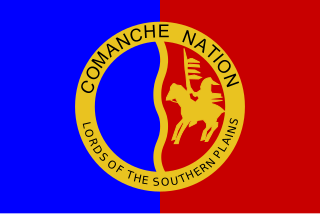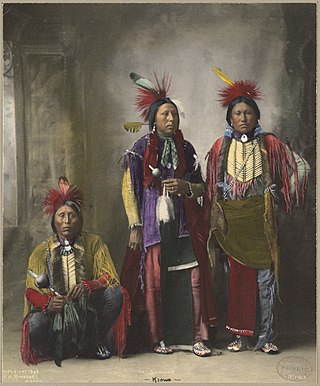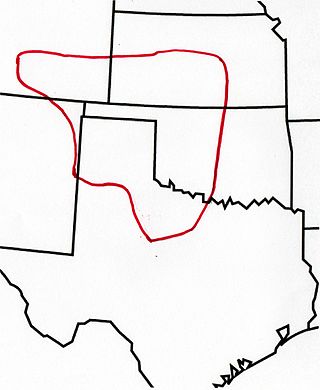Related Research Articles

The Comanche or Nʉmʉnʉʉ is a Native American tribe from the Southern Plains of the present-day United States. Comanche people today belong to the federally recognized Comanche Nation, headquartered in Lawton, Oklahoma.

Francisco Vázquez de Coronado was a Spanish conquistador and explorer who led a large expedition from what is now Mexico to present-day Kansas through parts of the southwestern United States between 1540 and 1542. Vázquez de Coronado had hoped to reach the Cities of Cíbola, often referred to now as the mythical Seven Cities of Gold. His expedition marked the first European sightings of the Grand Canyon and the Colorado River, among other landmarks. His name is often Anglicized as Vasquez de Coronado or just Coronado.

Palo Duro Canyon is a canyon system of the Caprock Escarpment located in the Texas Panhandle near the cities of Amarillo and Canyon. As one of the large canyons in the United States, it is roughly 25–40 mi (40–64 km) long and has an average width of 6 mi (9.7 km), but reaches a width of 20 mi (32 km) at places. Its depth is around 800 ft (240 m), but in some locations, valley bottom to surrounding hills increases to 1,000 ft (300 m). Palo Duro Canyon has been named "The Grand Canyon of Texas" both for its size and for its dramatic geological features, including the multicolored layers of rock and steep mesa walls, which are similar to those in the Grand Canyon. It is part of Palo Duro Canyon State Park. The State Park had 442,242 visitors in 2022.

Kiowa or CáuigúIPA:[kɔ́j-gʷú]) people are a Native American tribe and an Indigenous people of the Great Plains of the United States. They migrated southward from western Montana into the Rocky Mountains in Colorado in the 17th and 18th centuries, and eventually into the Southern Plains by the early 19th century. In 1867, the Kiowa were moved to a reservation in southwestern Oklahoma.
The Apache are several Southern Athabaskan language–speaking peoples of the Southwest and the Southern Plains. They are linguistically related to the Navajo. They migrated from the Athabascan homelands in the north into the Southwest between 1000 and 1500 CE.
Lipan Apache are a band of Apache, a Southern Athabaskan Indigenous people, who have lived in the Southwest and Southern Plains for centuries. At the time of European and African contact, they lived in New Mexico, Colorado, Oklahoma, Texas, and northern Mexico. Historically, they were the easternmost band of Apache. Early adopters of horse culture and peyotism, the Lipan Apache hunted bison and farmed.

The Llano Estacado, sometimes translated into English as the Staked Plains, is a region in the Southwestern United States that encompasses parts of eastern New Mexico and northwestern Texas. One of the largest mesas or tablelands on the North American continent, the elevation rises from 3,000 feet (900 m) in the southeast to over 5,000 feet (1,500 m) in the northwest, sloping almost uniformly at about 10 feet per mile (2 m/km).

West Texas is a loosely defined region in the U.S. state of Texas, generally encompassing the arid and semiarid lands west of a line drawn between the cities of Wichita Falls, Abilene, and Del Rio.

Mescalero or Mescalero Apache is an Apache tribe of Southern Athabaskan–speaking Native Americans. The tribe is federally recognized as the Mescalero Apache Tribe of the Mescalero Apache Reservation, located in south-central New Mexico.

The Wichita people, or Kitikiti'sh, are a confederation of Southern Plains Native American tribes. Historically they spoke the Wichita language and Kichai language, both Caddoan languages. They are indigenous to Oklahoma, Texas, and Kansas.

Plains Indians or Indigenous peoples of the Great Plains and Canadian Prairies are the Native American tribes and First Nation band governments who have historically lived on the Interior Plains of North America. While hunting-farming cultures have lived on the Great Plains for centuries prior to European contact, the region is known for the horse cultures that flourished from the 17th century through the late 19th century. Their historic nomadism and armed resistance to domination by the government and military forces of Canada and the United States have made the Plains Indian culture groups an archetype in literature and art for Native Americans everywhere.

The Comancheria or Comanchería was a region of New Mexico, west Texas and nearby areas occupied by the Comanche before the 1860s. Historian Pekka Hämäläinen has argued that the Comancheria formed an empire at its peak, and this view has been echoed by other non-Comanche historians.

The Tiguex War was the first named war between Europeans and Native Americans in what is now part of the United States. The war took place in New Spain, during the colonization of Nuevo México. It was fought in the winter of 1540-41 by the expedition of Francisco Vázquez de Coronado against the twelve or thirteen Pueblos of what would become the Tiguex Province of Nuevo México. These villages were along both sides of the Rio Grande, north and south of present-day Bernalillo, New Mexico.
Quivira was a province of the ancestral Wichita people, located near the Great Bend of the Arkansas River in central Kansas, The exact site may be near present-day Lyons extending northeast to Salina.
Teyas were a Native American people living near what is now Lubbock, Texas, who first made contact with Europeans was the 1541 Francisco Vásquez de Coronado Expedition.
Jusepe Gutierrez ,) was a Native Nahua guide and explorer. He was the only known survivor of the Umana and Leyba expedition to the Great Plains in 1594 or 1595. In 1599 he guided Vicente de Zaldivar and in 1601 Governor Juan de Oñate on expeditions to the plains.
Jumanos were a tribe or several tribes, who inhabited a large area of western Texas, New Mexico, and northern Mexico, especially near the Junta de los Rios region with its large settled Indigenous population. They lived in the Big Bend area in the mountain and basin region. Spanish explorers first recorded encounters with the Jumano in 1581. Later expeditions noted them in a broad area of the Southwest and the Southern Plains.
The Antelope Creek Phase was an American Indian culture in the Texas Panhandle and adjacent Oklahoma dating from AD 1200 to 1450. The two most important areas where the Antelope Creek people lived were in the Canadian River valley centered on present-day Lake Meredith near the city of Borger, Texas and the Buried City complex in Wolf Creek valley near the town of Perryton, Texas. Settlements are also found in Oklahoma near the town of Guymon and along the Beaver River.

A Cibolero was a Spanish colonial buffalo hunter from New Mexico. The Spanish word for buffalo as used in New Mexico is cibolo; hence, the name Cibolero for buffalo hunter.

The Southern Plains villagers were semi-sedentary Native Americans who lived on the Great Plains in western Oklahoma, Texas, Kansas, and southeastern Colorado from about AD 800 until AD 1500.
References
- 1 2 3 4 5 "Apache". Texas Beyond History. Texas Archeological Research Laboratory, University of Texas–Auston. 1 August 2005. Retrieved 18 February 2024.
- ↑ Winship, George Parker, ed. and trans., The Journey of Coronado, 1540-1542, from the City of Mexico to the Grand Canon of the Colorado and the Buffalo Plains of Texas (New York: A.S. Barnes & Company, 1904), pp. 65, 112, 194.
- ↑ Foster, William C. Historic Native Peoples of Texas. Austin: U of Tex Press, 2008, 143
- ↑ Mecham, J. Lloyd, "The Second Spanish Expedition to New Mexico," New Mexico Historical Review, Vol. 1, No. 3, July 1926, 284
- ↑ Hammond, George P. and Rey, Agapito, The Rediscovery of New Mexico, Albuquerque: U of NM Press, 224
- ↑ Robert Blasing, "Pre-European Cultural Relationships between the Plains and Southwest Regions," 10-12. Accessed, Mar 1, 2010; Wilcox, David R. "The Entry of Athapaskans into the American Southwest: The Problem Today" Accessed, Mar 1, 2010
- ↑ Hammond and Rey, 224